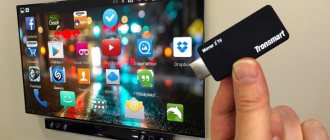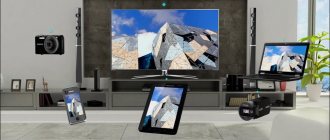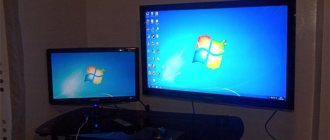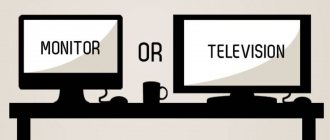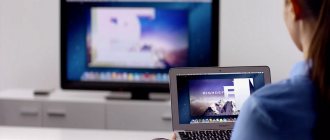If you purchased a new TV, changed your cable operator or broadcast type, then the first procedure you will encounter is setting up TV channels on your TV.
Depending on the method of signal reception, there are three main types of broadcasting:
- terrestrial - broadcast from a TV tower is transmitted to a regular antenna;
- cable - channel packages from the operator's distribution center are transmitted to subscribers' apartments by wire;
- satellite - the signal from the satellite is transmitted to a parabolic antenna (dish) and converted by the receiver.
In turn, terrestrial and cable television can be analogue and digital. The second has higher image and sound quality, but viewing it may require additional equipment in the form of a digital set-top box (tuner), especially if we are talking about an older TV model.
This article discusses automatic and manual tuning of analog channels on a TV (for cable channels everything will be identical).
What is a receiver
Digital television operates in a modern digital format. New technologies have improved sound and picture quality. In addition to 20 basic TV channels, digital catches more than 300 different TV programs and is constantly expanding its range.
Most older TVs, including LCD or plasma, are configured to work with an analog DTV (Digital Television) signal. It is transmitted in the AM band at FM radio frequencies. The transmission quality is low due to the large amount of interference. And the further the reception point is from the radio tower, the worse it is.
In order for the quality of television broadcasting to move from 525 lines, 60 fields and 30 frames to Full HD standards, you must connect the receiver to a TV.
Features of digital TV broadcasting
Analogue television operates using the standard DVB-C protocol. Digital broadcasting transmits signals in three ways:
The equipment for decoding the signal is selected depending on its type. TVs with a built-in T2 receiver do not require auxiliary devices.
How tuners work
Based on the types of digital television transmission signals, there are three types of receivers: cable, terrestrial, satellite.
Regardless of the type, all tuners work on the same principle:
You need to connect the receiver to the TV specifically to “convert” a digital signal into an analog signal without losing the quality of sound and image.
Which TV doesn't need a set-top box
Modern TV models are equipped with a built-in or external T2 tuner. For such options, no additional attachment is required. You can check the availability of such equipment in your TV on the manufacturer’s official website, for example, go to the Samsung website and type in the TV model in the appropriate section.
Smart TV, which operates over an Internet connection, does not require receivers. The quality of broadcasting in this case depends on the speed of data transmission over the network and the reliability of the connection to it.
Does the TV support digital format?
Most Akai TVs do not support the DVB-T2 digital television format. To make sure that the TV is digital, look at the instructions for it. This information can also be viewed on the Internet. The most convenient option to check support for digital TV is to go to the website Look at the Russian Federation, this is the RTRS website, there is a column to check your TV.
Ways to connect the receiver to the TV
The set-top box comes with a cable with an adapter for connecting to the mains and an adapter for connecting to a TV (not always). Before purchasing equipment, look at what connectors are on the TV itself. In most Samsung and LG models they are displayed on the back or side panel.
In total, there are 7 options for connecting the receiver to the TV: RCA, Scart, HDMI, DVI/D-SUB, LAN, CAM module, antenna input.
General connection diagram
A separate device (set-top box) is connected directly to the signal source, power supply, or TV. The general diagram for connecting the receiver to the TV is as follows:
If the receiver is correctly connected to the TV, the channels will be tuned in quickly and 20 free TV shows will be immediately available. If you have paid a paid connection to the Internet and TV from an operator offering services in your home, for example, Tricolor, specialists are required to connect and start the equipment themselves.
Via RCA connector
The classic connection of old TVs is through tulips or an RCA connector. DVD set-top boxes and other equipment were previously connected in the same way. There are three connectors on each end of the cable: red, white and yellow. Yellow is not required to connect the receiver to the TV via tulips. The red and white wires are audio signals.
On the TV and set-top box, the tulip connectors are painted in the same colors. Additionally, they all have their own markings. The maximum quality that can be obtained with this option for transmitting digital channels is up to 1080p.
Important! Tulips are power cables. You can connect the RCA connector only when the power supply to the TV and set-top box is turned off.
Via Scart
The wide flat connector on the TV is suitable for receiving a digital signal. The Scart version is equipped with a wide connector on one end and tulips on the other, where the attachment is. This is a more compact and faster way to connect a tuner to a TV.
Connection via HDMI
A modern option for organizing digital television is to use an HDMI cable. This is high capacity coaxial wire. Connecting the receiver to a TV via HDMI allows you to watch TV channels with Full HD resolution.
Connecting equipment via DVI/D-SUB
Powerful, high-quality receivers, also used for Smart TV, have a video adapter. It provides high signal transmission speed, sound and image quality. As an adapter, you can use a cord to connect a classic monitor and the system unit of a personal desktop computer.
Important! To use this method of connecting the receiver to the TV, you need to check that the TV equipment has a D-SUB socket. In another case, you will need an auxiliary adapter, which slightly degrades the quality of television broadcasting.
LAN connection diagram
Universal Smart set-top boxes are equipped with a connector for connecting to the Internet - LAN. Data transmission is carried out using IPTV technology. It does not provide signal encoding and decoding. It is transmitted directly, which affects the high quality of image and sound.
Most often, IPTV is offered by cellular operators that provide Internet and digital TV in multi-storey buildings. In this case, a direct connection of the TV to the network is not required. For this purpose, a separate cable is used, routed into the apartment.
How to connect a CAM module
Satellite receivers are equipped with CAM modules. They allow you to watch not only 20 basic channels, but also connect to package offers from the selected operator. Essentially, the CAM module is a card installed in the receiver. It does not require any additional connection.
Connection via antenna input
Antennas and satellite dishes can be connected via the RF IN connector. It is universal and suitable for analog and digital television. This round input is present on all tuners, regardless of their year of manufacture and configuration.
How to set up digital TV on LG
If this instruction is not effective, you should use a detailed algorithm for LG TVs. The technique is relevant for almost all models of the manufacturer.
- From the remote control go to the Menu;
- Click on “Options”;
- In the “Country” category, change the checkbox to Finland or Sweden;
- Then go to the “Settings” category and launch “Autosearch”;
- In the fields you need to enter a search method, usually a fairly fast type, frequency - 298 MHz, modulation - 256 QAM, characters - 6952, ID - auto;
- If everything is done correctly, then during the search a number of TV channels will be displayed;
- The manufacturer LG integrates an automatic system for searching and updating TV channels into the system. This function can be inconvenient as the prepared list will be reset regularly. To prevent this phenomenon, be sure to go to the settings for connecting via cable and turn off “Auto channel update”;
- For convenient sorting, you need to remove the check mark from auto-numbering in the “Cable” section in “Autosearch”.
Is it possible to connect 2 TVs to one receiver at once?
Most modern apartments are equipped with two or three televisions at once. Users want to save money and get by with one set-top box. The ability to connect a tuner to two TVs at once is limited by the functionality of the receivers themselves. For example, Smart equipment has the option of dividing the signal into 2 broadcast options without loss of quality. The correct connection can be found in the instructions for the devices.
If there is no separation option, you can try connecting an antenna or cable TV to two equipment at once. To do this, you need to separate the cable using special adapters, run them to the TVs and tune the channels at different frequencies. If TV programs operate at the same frequencies, signal overlap will occur and the quality of audio and video transmission will deteriorate.
Only the antenna cable can be separated. It comes from a satellite dish or general wiring along the entrance. If digital signal decoding is required, a second set-top box will be required.
Now you know all the ways to connect the receiver to a TV to watch digital channels. Choose the appropriate option, buy adapters if necessary and enjoy watching.
Source
Connecting and setting up satellite TV
Satellite TV will require the same components as cable TV, but a satellite antenna will naturally be needed. Please note that some manufacturers sell a device that comes with a receiver and converter. For example, you can buy these from Tricolor, NTV Plus, MTS and others.
Step 1: pointing at the desired satellite:
When installing a satellite dish on the balcony of a high-rise building or the roof of a private house, it is important to position the device so that it is aimed at the corresponding satellite. Here is a list of satellites that have Russian channels and give a good signal in Russia:
- Hot Bird – 130 E (East longitude).
- Express AMU1 – 360 east. for Tricolor TV and NTV+.
- Express AM6 – 530 east.
- Yamal 402 – 54.90 east.
- Express AT1 – 560 east. for Tricolor Siberia and NTV+Vostok.
- ABS 2 – 750 in.d. for MTS TV.
- Horizons 2 and Intelsat 15 – 850 east. for Continent TV and Telecard.
In addition to these, there are still enough satellites that have both paid and free channels.
Step 2: Connecting Cables
As with cable television, the antenna cable must be connected to the receiver, which in turn must be connected to the TV. We will not describe this process in detail, since it is similar to connecting cable TV (see step 1 of cable digital TV).
Step 3: Setting up channels:
- Automatic setup. On the remote control, press “Menu” and in the “Channels” section select “Auto search”. In this section, select your provider and look for channels. Please note that, unlike digital TV, satellite auto search will find and save you a couple of hundred different channels, more than half of which will be in a foreign language. After finishing the auto search, you will have to sift out a lot of unnecessary ones.
- Manual setting . In the “Channels” section, select “Manual tuning”. Here, choose only those channels that you will actually watch at least sometimes. Channels about nature, travel and sports are very popular. They are mostly free.
Necessary equipment
A gradual transition from analogue to digital broadcasting is taking place throughout Russia. Some channels can still be viewed using the TV's built-in tuners that decode the analog signal. But it will be possible to receive a larger number of consistently broadcast television channels with improved parameters of video and audio signals only by switching to the new DVB-T2 standard.
Reference. DVB-T2 is an abbreviation for Digital Video Broadcasting-Second Generation Terrestrial, which translates from English as Digital Video Broadcasting-Terrestrial of the Second Generation.
What's already included: standard equipment
Most modern TVs from well-known electronics manufacturers have a built-in DVB-T2 tuner. Information about this can always be found in the instructions for your existing television receiver.
For earlier models and older TVs, to receive a signal in digital format, you will have to purchase a DVB-T2 set-top box (receiver), of which there is currently a wide variety. They differ not only in appearance, case material and equipment, but also in the processor and the functionality of the tuner itself.
The standard receiver model usually has the following equipment:
What else is needed: additional equipment
To receive a digital signal, in addition to the set-top box, you need a television antenna with a decimeter range of received frequencies (UHF, frequencies from 300 MHz to 3 GHz).
Attention. If a centralized antenna with apartment wiring is installed in the house (not to be confused with cable television), then there is no need to purchase an individual one.
When choosing an antenna, the most important factors are:
If the TV tower is in direct line of sight, and the number of wall partitions to the outer wall is not large, it is best to purchase an indoor antenna.
If the distance to the repeater is large, and the house is located in a low-lying area or is blocked by tall buildings, you need to buy an external active (with a built-in amplifier) antenna, which can be installed on the roof or on a special mast. In this case you will need:
Important. In some set-top boxes, a constant voltage can be supplied to the antenna input jack (turned on in the receiver menu), and in such cases an external power supply for the antenna amplifier is not needed.
To connect the set-top box to the TV, instead of the standard analog RCA connection, you can use an HDMI cable if these devices have the appropriate connectors.
Its use, thanks to its high bandwidth, allows it to support the transmission of multi-channel digital audio signals and high-definition digital video signals.
Akai TV answers to questions
Problems setting up your TV
The settings of the Akai LEA-19L14G TV have been reset; when you press the menu on the remote control, only the picture mode, sleep timer mode, menu language and that’s it! Previously there was a manual or automatic setting, but now you can’t find it. Shows no signal, connection cannot be configured. How to access settings automatically or manually through the menu?
Akai AKTV 4026 “I bought a TV in Europe, there is no Russian language, how to set it up? (there was samsug there you can configure it using a combination of buttons, changing Europe to Asia)
AKAI UA40LEP1T2S “In the settings menu there is no icon and line for setting up channels. IMAGE - yes, SOUND - yes, SETTINGS - yes, TIME - yes, LOCKING - yes. CHANNELS - none.
Akai ST-1407D There is no color when switching to digital. As I understand it, you need to switch the TV to Pal color mode, since the set-top box works in this mode. But I can't enter the custom (on-screen) menu of the TV. There is no “Menu” button on the remote control, nor is there one on the TV panel. How to do it.
AKAI LEA-32H50P The TV does not search for digital channels. How can I configure it myself?
4.26.2019 LEA-32V96M V1.0 “When you connect a new TV, an inscription appears in the upper left part that the device is not detected, and two horned icons. What this means is not found in the instructions. Could this indicate a problem with the antenna or do you need to press something to switch to the TV broadcast mode, since the screen displays 4 squares with the names of third-party devices, between which switching from the remote control (arrows) works. But no keys on the remote control display the TV device itself. The antenna is a public house one, but the cable is old and has soldered extensions, which did not work well on the previous vintage TV (with periodic interference). Do I need to replace a new antenna or is this picture on the screen normal and should I switch something on the TV itself?”
22/12/2020 AKAI LEA-24D102M The TV does not receive digital channels without an additional digital set-top box. Everything works with the console. How to set up without it, only with an external antenna?
08/21/2021 AKAI CT-2015DK Hello, please explain how to set up channels on the TV
09.16.2021 Akai LEA-24D102M “I bought a TV to replace my mother’s broken one. At home I connected it to the common house antenna. Set up all channels: digital, analog, radio. I took the TV to my mother. Connected it to her common house antenna. It says “no signal”. I connect the antenna to a nearby Sony TV - everything works. I connect to Akai - no signal. Help me figure out what the problem is?”
Exit to the settings section by pressing the MENU button on the remote control. Use the Left/Right navigation buttons to select the CHANNEL menu. To exit the menu, press the MENU or EXIT button on the remote control.
If there is no Channel setting option on the screen, the TV is most likely in external AV input mode. It is necessary to switch Akai LEA-19L14G to TV signal reception mode.
The old TV was probably configured to receive over-the-air signals. Retune the LEA-24D102M to channels, installing the DVB-T2 over-the-air tuner option.
Problems with the remote control
3.1.2020 How to use the remote control a1001026 Akai LEA-19V07P to switch to a digital set-top box.
akai LEA-32P37P how to open the service menu on the TV, provided that the remote control is not original, the original one is broken.
The remote control a1001026 Akai is additional; it does not have buttons for entering the Menu and switching operating modes. To connect a digital set-top box, use the main remote control to press the SOURCE button on the remote control and select the input used: AV, SCART, YPbPr or HDMI. You can also enter this mode using the TV/AV button on the TV body; the selection is made using the channel switching buttons, confirming the selection with Enter.
Image Settings
1.24.2021 Akai UA43DM2500US9 There is no function in the settings (image settings) I can’t change the brightness
14/2/2021 Akai 2141 HS EE How to enter the menu from the TV
Key lock
6.9.2019 AKAI LEA-22E17P Accidentally blocked the buttons without the remote control, there is no remote control, you can unlock the button lock.
Akai UA43EK1100US The TV suddenly stopped responding to turning on the media menu and turning on the browser from the remote control. On the TV itself there are no buttons to turn them on, the mouse also does not turn on these menus, only the settings menu is the usual brightness, sound, etc., the TV only works in cable TV mode. Tell me, please, maybe some program crashed or maybe the wrong buttons on the remote control were pressed in combination? (The cat could have walked on the remote control...) Is it possible to somehow roll back to factory settings?
Firmware, software update
10/6/2021 AKAI UA40LEP1T2S LIGHT BLINKED TV WILL NOT START SMART CIRCLES SPINING WILL NOT START FIRMWARE NEEDED
Connecting external devices
16/7/2021 AKAI LEA -32L41P How to return the settings, the child clicked. Four windows appeared: photos, music, movies, text.
16/6/2021 AKAI Ua32DM1100 The TV worked perfectly, now the information appears on the screen: insert a usb device. I click ok, but this information is not removed from the screen.
Your TV is in USB device connection mode. The selection of the signal source, including TV for viewing TV channels, is carried out by the SOURCE button.
08/28/2021 AKAI RC-G21 How to connect a media player to a TV media 3 tulips and to a TV 2
You incorrectly indicated the TV model, RC-G21 is the designation of the remote control, the model is indicated on the nameplate on the back cover. If the TV has two inputs, you need to connect the yellow tulip to the yellow video input, and connect one of the remaining ones - white or red - to the audio input.
Setting up Smart TV Akai
Setting up channels via the Internet
05/01/2020 Akal UA32DM1100T2 How to set up television channels via the Internet Akai ua24df2110s How to set up channels via Wi-Fi
Purpose of connectors: what is needed for what?
To transmit a signal between electronic devices that work together (in this case, an antenna, a receiver and a TV), they must have input and output connectors, as well as connecting cables.
Device connectors and cable plugs may have different standards, and the user must clearly understand their connection.
Standard connectors
With all the variety of set-top boxes, the main connectors located on the rear panel are similar:
There may also be a USB port on the front panel, providing the user with the following options:
Rare connectors
Some DVB-T2 devices may also have other connectors:
Setting up Smart TV
Devices with the Smart TV function allow you not only to watch TV channels, but also to surf the Internet and even talk on Skype (if you have a camera and microphone). For normal operation, you need to connect the plasma to the Internet. There are two ways to do this.
Method 1: Connection via cable:
- We connect the LAN cable from the modem to the TV into the appropriate port (which is indicated in the picture).
- We check the presence of Internet in the modem or router.
Connecting a digital set-top box
The choice of set-top box, as well as its connection, very much depends on the year of manufacture of the television receiver, and, consequently, the presence of input ports of a certain standard on it.
To a modern TV
When connecting a modern television receiver to a DVB-T2 device, of all the input connectors it has, it is best to use HDMI, since this interface is designed for high-definition multimedia, and using one cable you can immediately transmit digital video and stereo audio signals.
Reference. An HDMI-to-HDMI cable is usually not included as standard and must be purchased separately.
Connect the receiver to the TV in the following sequence:
To the old TV
Old TVs mean models that already have 3 RCA input connectors, but do not have an HDMI port.
The connection is made in the same way as the previous one, but using a cable with “tulips” included in most receivers, and the colors of the sockets on both devices and on the cable plugs must match each other.
If the TV has one speaker, and therefore one audio input, a white plug is connected to it, and a yellow plug is connected to the video input.
After turning on the set-top box and the TV, use the “SOURCE” button on the remote control of the TV receiver to select the AV signal source.
Attention. You can also connect modern TVs with a 3 RCA-3RCA cable, but the image quality will be worse due to the transition of the digital signal to analog.
Owners of television receivers that have only SCART, D-SUB, DVA or S-VIDEO connectors at the input will face an even greater problem. To connect them, DVB-T2 devices must have similar outputs. You will also need to purchase connecting cables.
After connecting both devices to the network, depending on the selected connector, on the TV using the “SOURCE” button on the control panel, select the desired signal source SCART, PC or AV.
How to set up an Akai TV
The experts of our company service and configure the Akai TV to television channels, connect to the Internet, and adjust the optimal image and sound parameters. Akai TVs are serviced on site at the customer’s location in all areas of Moscow and the surrounding Moscow region. We know how to set up channels on an Akai TV .
Akai TV instructions
The Akai TV manual contains information on connecting external devices to the Akai LEA-32L34P TV, setting up all TV parameters, possible malfunctions and how to eliminate them. Features of the TV are: Sensitive TV tuner Video inputs: VGA, YPbPr, 2 x HDMI, VIDEO Audio inputs: PC Audio, Stereo audio input (RCAxR/L) Headphone output Channel tuning: automatic/manual (memory for 199 channels)
Edit/skip/delete stored channels Automatic shutdown when there is no signal Rated sound power 2 x 6 W Sleep timer / Auto power off Supports CATV mode, the TV receives all cable channels Teletext function 1000 pages HDMI interface that allows you to receive copyrighted material from high-quality digital sources resolution without loss of quality Screen format: 16 : 9 High-quality energy-saving LCD matrix with LED backlight
Akai TV remote control
Akai TV remote control The
Akai TV remote control is shown in the figure: 1 - button to turn on/off the TV standby mode 2 - temporarily mute the sound 3 - digital channel selection buttons 4 - freeze frame 5 - return to the previous channel 6 - switch stereo sound modes 7 — selection of preset picture modes 8 — selection of preset sound modes 9 — setting the sleep timer 10 — selecting a signal source 11 — entering/confirming the selected operation 12 — navigation buttons, moving left/right in menu mode 13 — navigation buttons, moving in menu mode up/down 14 — call the on-screen menu 15 — exit the settings menu 16 — display channel information 17 — adjust the volume level 18 — switch channels in ascending/descending order 19 — select the image size 20 — quickly enter the Media mode 21 - play/pause in Media mode 22 - select your favorite channel (list of channels) 23 - stop playback in Media mode 24 - button to play the previous file in Media mode 25 - button to enable fast playback in Media mode 26 - button to play the next file in the mode Media 27 - button to enable fast forward playback 1* - colored buttons for quick access to teletext information 2* - enable teletext - return to normal page size. 3* — turn subtitles on/off 4* — turn off teletext 5* — hold or resume page rotation 6* — first press — teletext mode; when pressed again - teletext mode with picture mode; on the third press - switches off the teletext mode 7 * - on the first press - the top of the page is doubled. When pressed again, the bottom of the page will double in size. The third press returns to normal teletext mode. 8* - direct selection of the teletext main page 9* - display of hidden information 10* - selection of subpages 11* - page turning up/down
On our website you can download the TV remote control, location and designation of remote control buttons, as well as instructions and user manual
How to set up an Akai TV the first time you turn it on
How to set up an Akai TV when you plug it in for the first time: When you turn on the TV for the first time, you need to select the language in which the system menu and information will be displayed. To do this, press the MENU button on the remote control or TV to display the system menu. Use the ◄► buttons on the remote control or VOL+/VOL- on the TV to select the SETTINGS menu. To exit the menu, press the MENU button on the remote control or TV, or EXIT on the remote control. To enter the PARAMETERS menu, press the OK button on the remote control. Use the ▲▼ buttons on the remote control or CH+/CH- on the TV to select Menu Language. Use the ◄► buttons on the remote control or VOL+/VOL- on the TV to select the menu language, for example, Russian.
Setting up channels
After all devices are correctly connected to each other and power is supplied to them, you can begin setting up TV channels. For this:
After this, the device will go to the “Auto Search” submenu and will automatically find all digital television and radio channels transmitted from the repeater and save them in memory.
Important. On this Search page, in the Antenna Power line, you can turn on or off the DC power supply to your external active antenna amplifier.
Checking the signal quality
It happens that the number of TV channels received by the purchased set-top box is less than that broadcast by the nearest TV tower.
Most often, the reason is not in the receiver, but in the quality of the signal coming to it.
There are special instruments to check the level (power) of the signal and its quality (signal-to-noise ratio), but this can also be done using one of the receiver’s functions.
When you click on the “ ” button, two indicator strips with percentages appear in the right corner of the screen. The top one shows the signal level, the bottom one shows its quality. If the signal level is below 50%, care should be taken to increase the input signal power. This is achieved as follows:
Preparing the TV
Before you start directly setting up channels, you should connect the TV to the broadcast source. With an analog signal, the cable from the antenna or cable television operator is connected directly to the antenna input of the TV (marked in the photo):
At the same time, it is worth separately considering the situation in which more than one TV is used in the apartment. In this case, a special antenna splitter is used for connection, which in most cases has two or three outputs:
How to tune channels from a regular antenna to several TVs?
People often complain that the channels on their TV in one room are worse than in another. Some of them are missing, and the rest have interference. This is due to an incorrect connection. It is important that both TVs are equidistant from the main cable. Otherwise, the one that is located closer will take over most of the signal. Also, to connect two or more TVs, you should use a high-quality cable that is better protected from interference. Therefore, a standard cheap cable, which is usually offered by many cable television operators, will not work here.
Connecting multiple TVs to one set-top box
There are 2 ways to connect two or three TVs to one set-top box:
1. Another receiver is connected to the through antenna output of the RF OUT (LOOP) set-top box via a piece of coaxial cable, and a second television receiver is connected to it. The main advantages of this connection:
The disadvantage is the need to buy another receiver.
2. Since the set-top box usually has an HDMI port, RCA output jacks, as well as some rare connectors (SCART, D-SUB, DVA, S-VIDEO), you can also connect several TVs to them using cables.
There will be one advantage - you won’t need to spend money on another console. But there is also a very significant drawback - the same channel will be broadcast on all receivers.
Setting up an old TV
To watch digital TV channels on your old Akai TV, use a digital set-top box.
To connect it, use Tulip cords. This cable must be connected according to the lights on the connectors. You can also use other connection methods available for your TV.
After connecting, you should start setting up channels on the set-top box itself by going to the auto search section.
Possible problems and their solutions
Problems can arise with any electronic device, and when they work together, the number of possible problems also increases. The user should be able to identify them and, in simple cases, correct them independently.
Channels are not picked up at all
There can be many reasons:
It is necessary to check each of the possible faults step by step and, having identified it, repair or replace one of the devices that is suitable for reception or serviceable.
Only part of the channels are caught
The receiving device must be redirected.
Weak signal
The level (power) of the signal can be influenced by various factors:
To fix this you need to:
In the latter case, wait it out.
No signal
This problem may arise due to unfavorable weather conditions:
In this case, the user:
Due to repair or maintenance work, the repeater may be temporarily turned off. All we can do here is wait.
The image slows down or freezes
If home electronic equipment works without any problems most of the time, then slowdowns in broadcasting and freezing of the image are the fault of malfunctions in the repeater.
Instructions and codes for setting up a universal remote control for your TV
Equipment manufacturers try to provide each of their devices with a remote control so that the user can conveniently use their products. You don’t need to get up to turn off the lights, adjust the air conditioner, fan, or turn on/off the TV; you can do everything while sitting on the couch. This is, of course, convenient, but over time, coffee tables become cluttered with different remote controls, which creates a certain amount of confusion and irritation.
If you don’t yet know that there is a universal remote control that can be configured to control several devices at once, then in this article we will tell you about all its capabilities and provide instructions on how to use it and how to configure it correctly.
What is a universal remote control
If you have become a happy user of digital television, then a new device with a remote control has appeared in your apartment - a set-top box-receiver. And in order not to add another remote control to your everyday life, let's figure out how to use a universal remote control.
Despite all the breakthroughs in technology, remote control devices have not changed at all. They may have different shapes, but the design of any remote control still consists of a housing, an electronic circuit, buttons, LEDs, and an autonomous power supply.
The universal remote control has an identical internal structure, only it can be configured to control several devices at once. For example, having purchased such a device, you can put the television, set-top box and multimedia remote control in the closet, and register all their functions in a universal remote control.
Can any remote control be universal? No. Although they are similar in appearance, their internal electronic circuitry is different. Only devices designed for this purpose can be configured to control multiple devices.
The difference between the original and universal remote control
A TV remote control, for example, the Tricolor TV, is a useless device in itself; it can only be used in conjunction with another device - the television receiver for which it was created.
The operating principle of the remote control is based on three actions:
- When you press a button on a device, you mechanically activate a microcircuit that creates a specific sequence of electrical impulses;
- The LED element of the remote control converts the received command into infrared radiation with a wavelength of 0.75-1.4 microns, and sends the signal to the associated device;
- The TV has a phototransistor that detects this IR signal and converts it into its own electrical impulse, transmits it to its control unit, due to which the command you have given is executed.
The communication method used in remote controls is called PCM, or Pulse Code Modulation. Its peculiarity is that each command is assigned a separate 3-bit sequence, for example:
000 - turn off the TV;
001 — select the next channel;
010 — return the previous channel;
011 — increase volume;
100 — reduce volume;
111 - turn on the TV, etc.
That is, when you press a button on the remote control, the electronic circuit turns on the IR LED in accordance with a given pattern: “111” - ON, ON, ON, with a clear signal step length, for example, 3 milliseconds. If you selected the volume button, which has code 011, then the LED will perform three such actions with a predetermined delay: turn off, turn on, and turn on again.
There are three different types of remote controls on the market:
- Original;
- Unoriginal;
- Universal.
Original and non-original remote controls are control devices created for one specific model of technical devices. The only difference is that the first type is produced by the native manufacturing plant where the TV itself was assembled, while non-original remote controls are produced by different companies under license.
Universal remote controls (UPDU) are learnable control devices that:
- Can be customized;
- Suitable for many TV models;
- Can be used instead of a lost remote control for any technical device.
A universal remote control can be chosen by shape, size, color, design, depending on personal preferences. Inside such a device there is a special program and a special code base that allow you to determine signals from almost any TV.
The most common brands of universal remote controls are Supra, Huayu and Beeline.

